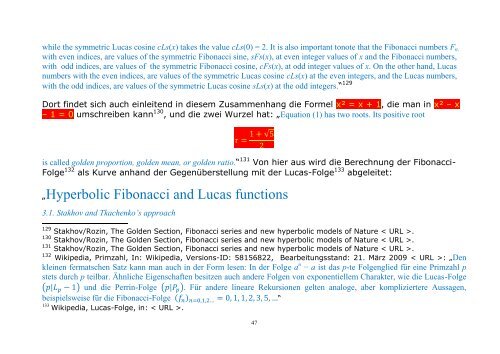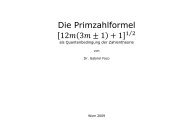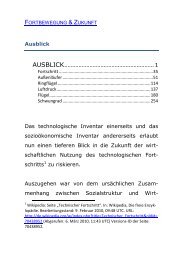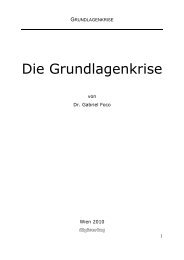Fibonacci - Home
Fibonacci - Home
Fibonacci - Home
Erfolgreiche ePaper selbst erstellen
Machen Sie aus Ihren PDF Publikationen ein blätterbares Flipbook mit unserer einzigartigen Google optimierten e-Paper Software.
while the symmetric Lucas cosine cLs(x) takes the value cLs(0) = 2. It is also important tonote that the <strong>Fibonacci</strong> numbers Fn,<br />
with even indices, are values of the symmetric <strong>Fibonacci</strong> sine, sFs(x), at even integer values of x and the <strong>Fibonacci</strong> numbers,<br />
with odd indices, are values of the symmetric <strong>Fibonacci</strong> cosine, cFs(x), at odd integer values of x. On the other hand, Lucas<br />
numbers with the even indices, are values of the symmetric Lucas cosine cLs(x) at the even integers, and the Lucas numbers,<br />
with the odd indices, are values of the symmetric Lucas cosine sLs(x) at the odd integers.“ 129<br />
Dort findet sich auch einleitend in diesem Zusammenhang die Formel x² = x + 1, die man in x² – x<br />
– 1 = 0 umschreiben kann 130 , und die zwei Wurzel hat: „Equation (1) has two roots. Its positive root<br />
is called golden proportion, golden mean, or golden ratio.“ 131 Von hier aus wird die Berechnung der <strong>Fibonacci</strong>-<br />
Folge 132 als Kurve anhand der Gegenüberstellung mit der Lucas-Folge 133 abgeleitet:<br />
„Hyperbolic <strong>Fibonacci</strong> and Lucas functions<br />
3.1. Stakhov and Tkachenko’s approach<br />
129 Stakhov/Rozin, The Golden Section, <strong>Fibonacci</strong> series and new hyperbolic models of Nature < URL >.<br />
130 Stakhov/Rozin, The Golden Section, <strong>Fibonacci</strong> series and new hyperbolic models of Nature < URL >.<br />
131 Stakhov/Rozin, The Golden Section, <strong>Fibonacci</strong> series and new hyperbolic models of Nature < URL >.<br />
132 Wikipedia, Primzahl, In: Wikipedia, Versions-ID: 58156822, Bearbeitungsstand: 21. März 2009 < URL >: „Den<br />
kleinen fermatschen Satz kann man auch in der Form lesen: In der Folge a n − a ist das p-te Folgenglied für eine Primzahl p<br />
stets durch p teilbar. Ähnliche Eigenschaften besitzen auch andere Folgen von exponentiellem Charakter, wie die Lucas-Folge<br />
und die Perrin-Folge . Für andere lineare Rekursionen gelten analoge, aber kompliziertere Aussagen,<br />
beispielsweise für die <strong>Fibonacci</strong>-Folge “<br />
133 Wikipedia, Lucas-Folge, in: < URL >.<br />
47






